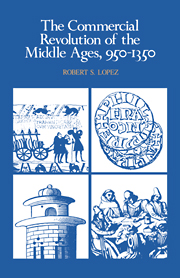Book contents
5 - BETWEEN CRAFTS AND INDUSTRY
Published online by Cambridge University Press: 03 December 2009
Summary
MERCHANTS AND CRAFTSMEN
The Industrial Revolution has so radically altered the relation between merchant and industrialist, that it takes some effort for us to realize how crucially important the capital, credit, connections, and initiative of merchants could be for the development of medieval crafts. Like his Roman counterpart, the medieval artisan tended to be the prisoner of a closed circle: he produced little because he had inadequate tools, and had inadequate tools because he did not produce fast enough to gather capital and invest it in mechanization. His horizons, too, were limited by his small productivity: he had neither the means nor the incentive to enlarge his operations by massive borrowing and hiring, or to broaden his market by searching for customers beyond his immediate reach. Whatever industrial growth had occurred in antiquity was due primarily to the interest that government officials and affluent landowners had in provisioning themselves; still the craftsmen, whether they were slaves or freemen, seldom rose to a high material and social standing, and if they did, usually hastened to change profession or live as gentlemen on unearned income. The early Middle Ages promoted slave artisans to serf status and occasionally paid lip service to the moral nobility of labor–were not St. Joseph and all the apostles laborers?–but offered no fresh opportunities for industrial development. From the tenth century on, however, the rise of the merchant class brought forth a new source of potential support.
- Type
- Chapter
- Information
- The Commercial Revolution of the Middle Ages, 950–1350 , pp. 123 - 147Publisher: Cambridge University PressPrint publication year: 1976



